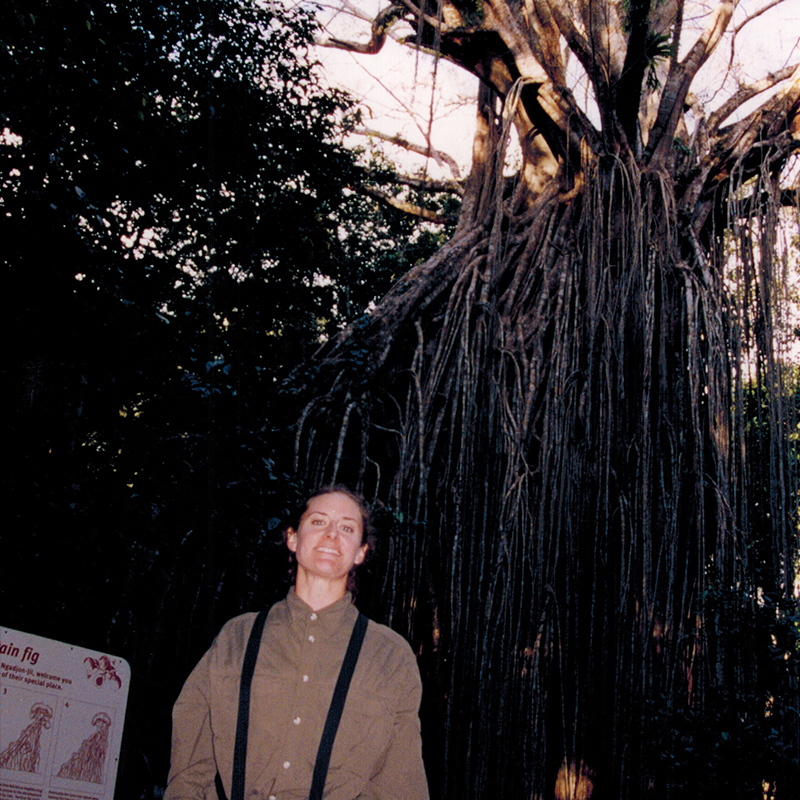 Next we drove up to the top of the Atherton Tablelands at roughly 3,000 feet above sea level. The drive through the dusty town of Mareeba took us through very dry country dotted with huge termite mounds the size of boulders. Much of the original, pre-settlement rainforest that used to predominate here has been converted to agriculture (corn, potatoes, wheat, sugar cane, bananas, etc.), making the few remnant patches of forest critical for wildlife. Luckily, this part of Australia has a great many national parks, conservation parks and state forest areas. The landscape became greener and the rolling farmland called to mind Ireland as we neared Yungaburra, a charming little historic town that sits in the middle of many protected areas. The closest is Curtain Fig National Park, where an enormous strangler fig tree’s long, cascading, tangled roots reportedly could take a week to count.
Next we drove up to the top of the Atherton Tablelands at roughly 3,000 feet above sea level. The drive through the dusty town of Mareeba took us through very dry country dotted with huge termite mounds the size of boulders. Much of the original, pre-settlement rainforest that used to predominate here has been converted to agriculture (corn, potatoes, wheat, sugar cane, bananas, etc.), making the few remnant patches of forest critical for wildlife. Luckily, this part of Australia has a great many national parks, conservation parks and state forest areas. The landscape became greener and the rolling farmland called to mind Ireland as we neared Yungaburra, a charming little historic town that sits in the middle of many protected areas. The closest is Curtain Fig National Park, where an enormous strangler fig tree’s long, cascading, tangled roots reportedly could take a week to count.
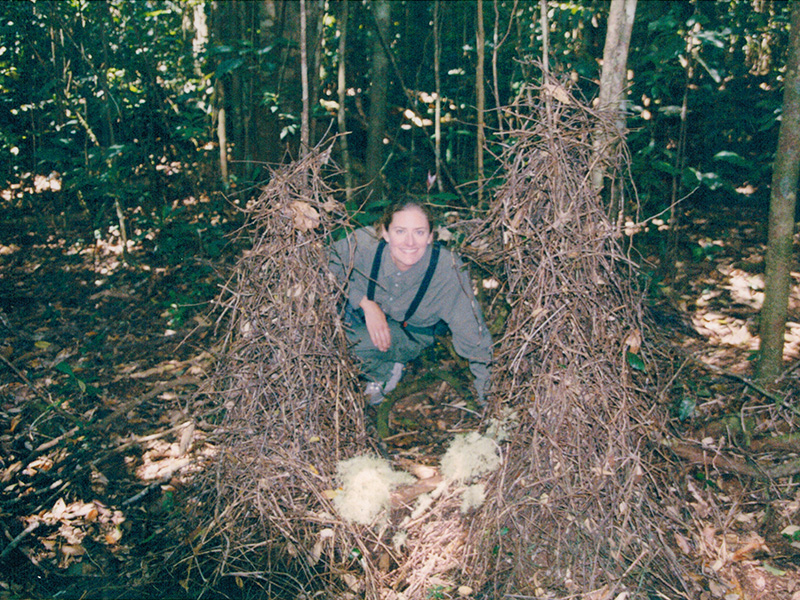 We met bird guide Alan Gillanders for an afternoon in the field to search for higher-altitude species. Like Del Richards down on the coast, Alan was a rather unexcitable guy, and he gave long, slow answers to each question. But he was good company and knew his birds. He pointed out the curious creation of a golden bowebird. Male bowerbirds build elaborate stick structures — some taller than I am — and decorate them with lichen, flowers, shells, broken glass, plastic bottle caps and other shiny, colorful bits of junk that they pick up here and there. This effort is meant to impress a female bowerbird with his construction skills and entice her into the bower (or “shag shack” as the locals called them) for a little romance. The nest is located elsewhere.
We met bird guide Alan Gillanders for an afternoon in the field to search for higher-altitude species. Like Del Richards down on the coast, Alan was a rather unexcitable guy, and he gave long, slow answers to each question. But he was good company and knew his birds. He pointed out the curious creation of a golden bowebird. Male bowerbirds build elaborate stick structures — some taller than I am — and decorate them with lichen, flowers, shells, broken glass, plastic bottle caps and other shiny, colorful bits of junk that they pick up here and there. This effort is meant to impress a female bowerbird with his construction skills and entice her into the bower (or “shag shack” as the locals called them) for a little romance. The nest is located elsewhere.
We also stopped near a tree-planting project of Alan’s that helped create one of the numerous wildlife corridors connecting forested patches, and in a nearby field more than 50 wallabies came bounding into view. This particular species was the agile wallaby, but I think they are misnamed, because on our drive through the Atherton Tablelands we saw dozens of smashed ones on the roadside that obviously had not been agile enough to avoid speeding cars at night.
 Nearing dusk we continued on to the Chambers Rainforest Lodge near Lake Eacham inside Crater Lakes National Park. On the road approaching the lodge, we saw not only a large python but also a red-legged pademelon — a marsupial that resembles a kangaroo — hopping off into the deep woods. The lodge host, John, has been observing these adorable creatures for decades and giving nightly introductions to the animals from a viewpoint on the deck overlooking a small lawn where the pademelons gather to feed at night. Some of the pademelons in the resident group act as security guards, patrolling the perimeter of the grounds. As we walked around we would suddenly come across one of the “guards” who would give us a wary glance and then thump around to let the other pademelons know we were no threat. At the approach of dingoes, however, the guard makes a different noise and everyone dashes off to safety.
Nearing dusk we continued on to the Chambers Rainforest Lodge near Lake Eacham inside Crater Lakes National Park. On the road approaching the lodge, we saw not only a large python but also a red-legged pademelon — a marsupial that resembles a kangaroo — hopping off into the deep woods. The lodge host, John, has been observing these adorable creatures for decades and giving nightly introductions to the animals from a viewpoint on the deck overlooking a small lawn where the pademelons gather to feed at night. Some of the pademelons in the resident group act as security guards, patrolling the perimeter of the grounds. As we walked around we would suddenly come across one of the “guards” who would give us a wary glance and then thump around to let the other pademelons know we were no threat. At the approach of dingoes, however, the guard makes a different noise and everyone dashes off to safety.
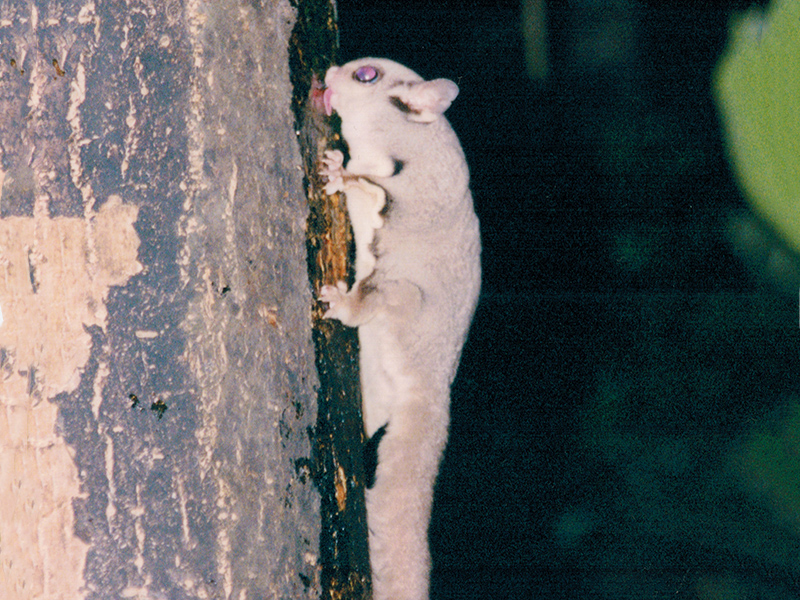 After we admired these animals we walked down to another viewing area to check out the sugar gliders. These delightful creatures spread their arms and legs to soar from tree to tree. They swoop in silently, so unless you’re very alert or happen to have one cross your field of vision, you merely hear a tiny thud as they land on a tree to lick the sugary solution that John’s daughter had applied to the trees. A bandicoot and a gigantic white-tailed rat also arrived to check out the sweet feast. The rainforest here buzzed with eerie night sounds and fascinating morning birdcalls, but because we were exhausted from each day’s activities, sleeping came very easily.
After we admired these animals we walked down to another viewing area to check out the sugar gliders. These delightful creatures spread their arms and legs to soar from tree to tree. They swoop in silently, so unless you’re very alert or happen to have one cross your field of vision, you merely hear a tiny thud as they land on a tree to lick the sugary solution that John’s daughter had applied to the trees. A bandicoot and a gigantic white-tailed rat also arrived to check out the sweet feast. The rainforest here buzzed with eerie night sounds and fascinating morning birdcalls, but because we were exhausted from each day’s activities, sleeping came very easily.
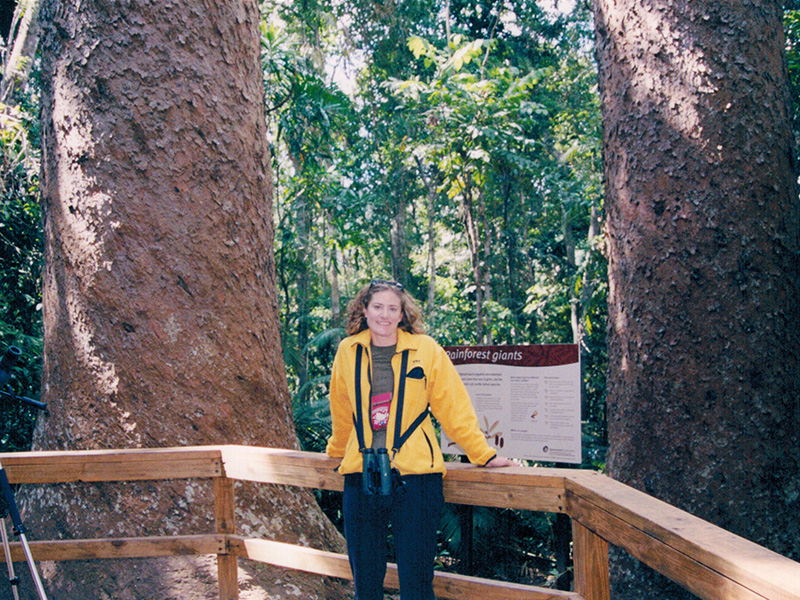 The next morning some Australian brush turkeys — arguably the country’s boldest birds — came strutting up the steps of the cottage to beg for a share of our breakfast. We met Alan again for a full day’s exploration of the area, and during a lunch stop at Lake Barrine National Park, (where 1,000-year-old twin kauri trees are one of the star attractions), another Australian brush turkey emerged from the woods as soon as we were out of the car. He circled around our picnic table, eyeing us inquisitively and eventually stalking off after he realized he would not get a handout.
The next morning some Australian brush turkeys — arguably the country’s boldest birds — came strutting up the steps of the cottage to beg for a share of our breakfast. We met Alan again for a full day’s exploration of the area, and during a lunch stop at Lake Barrine National Park, (where 1,000-year-old twin kauri trees are one of the star attractions), another Australian brush turkey emerged from the woods as soon as we were out of the car. He circled around our picnic table, eyeing us inquisitively and eventually stalking off after he realized he would not get a handout.
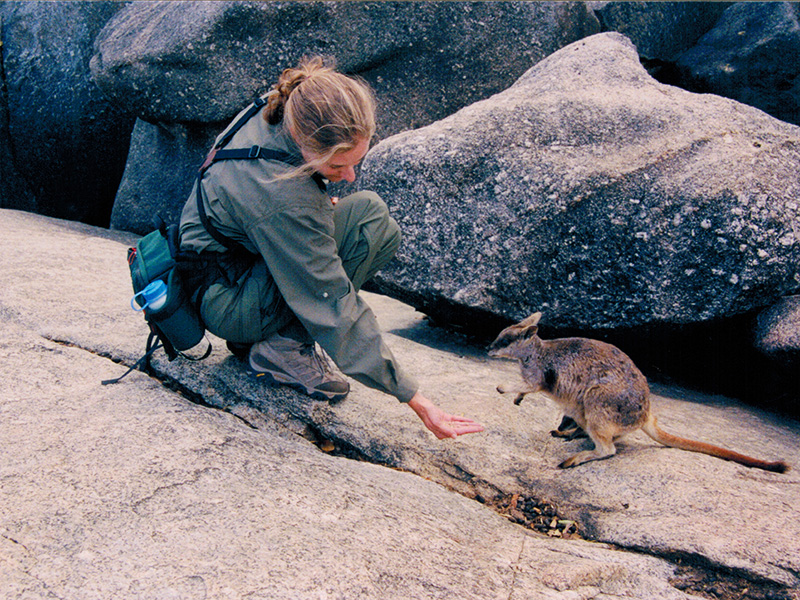 But we simply could not resist giving a handout to the Mareeba rock wallabies at Granite Gorge Nature Park, a private park set in the drier country up near Mareeba that hosts a colony of these sweet, gentle marsupials. Even though they are wild animals, people come here to feed them on the exposed boulders, and although ecologists might frown on the practice, I couldn’t help joining in. They hopped toward me and ate grains right out of my hands, and I could feel their soft, furry chins rubbing against my fingers as they licked the crumbs from my palm.
But we simply could not resist giving a handout to the Mareeba rock wallabies at Granite Gorge Nature Park, a private park set in the drier country up near Mareeba that hosts a colony of these sweet, gentle marsupials. Even though they are wild animals, people come here to feed them on the exposed boulders, and although ecologists might frown on the practice, I couldn’t help joining in. They hopped toward me and ate grains right out of my hands, and I could feel their soft, furry chins rubbing against my fingers as they licked the crumbs from my palm.
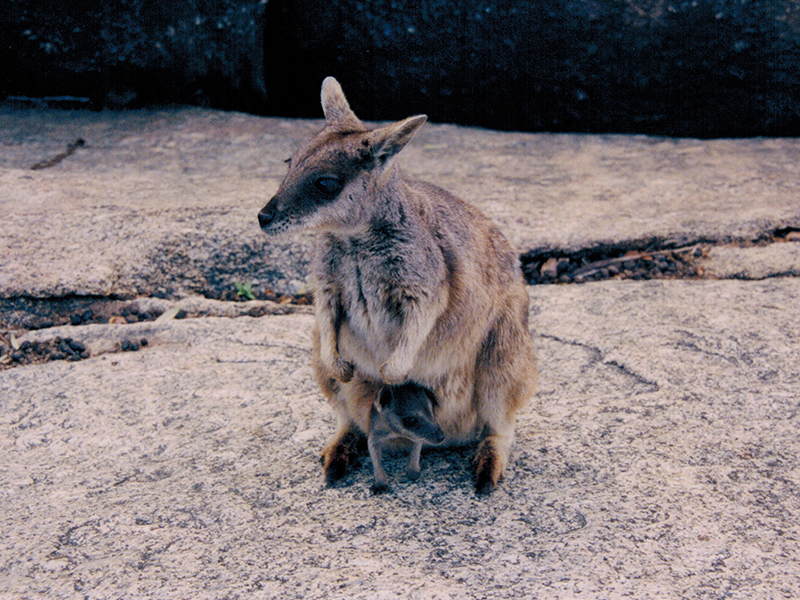
Nothing is cuter than a little joey sticking its head out of mom’s pouch as she looks into your eyes and puts her paw in your hand; the experience could melt the heart of the iciest person on Earth. Perhaps in my own way I am one of those cold-hearted people, though, because for dinner later that evening I ordered the kangaroo pie (yes, made with kangaroo meat). And it was delicious despite the twinge of guilt I felt, especially having spent most of the 1990s as a vegetarian. I felt another twinge of guilt when we went back out after dinner with Alan to spotlight nocturnal animals — which make up the vast majority of this country’s mammals — and saw the Lumholtz’s tree kangaroo, striped possum, coppery brushtail possum and green ringtail possum. Okay, maybe I should go back to being a vegetarian.
The golden bowebird is sure a handy builder, what an elaborate show of talent. You ate kangaroo meat?!
Yes, I did, and as guilty as I feel it was pretty good. You can get it here in the states, too, from farmed kangaroos.